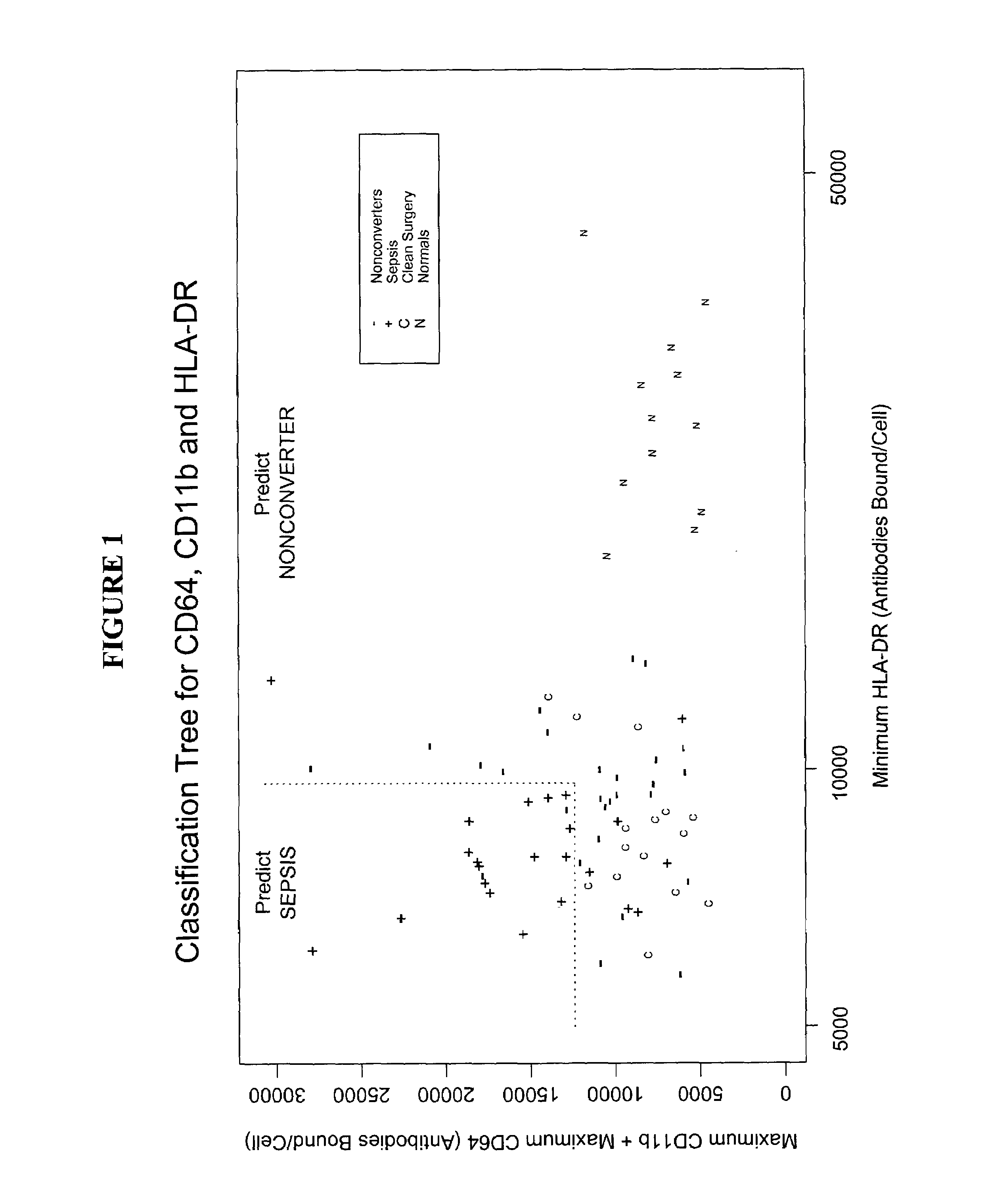Early detection of sepsis
a sepsis and early detection technology, applied in the field of early detection of sepsis, can solve the problems of complex process, high cost, and high complexity of early detection of disease symptoms, and achieve the effect of reducing the number and heterogeneity of factors, and accelerating the process of sepsis detection
- Summary
- Abstract
- Description
- Claims
- Application Information
AI Technical Summary
Benefits of technology
Problems solved by technology
Method used
Image
Examples
example 1
Preferred Protocols
Measurement of Cell-Surface Markers by Flow Cytometry
[0089]Cell-surface markers, HLA-DR, CD64, and CD11b, are assayed by flow cytometry. Flow cytometry is carried out using a BD FACSCalibur™ flow cytometry system and BD FACStation™ data management system with BD FACSComp™ software, version 4.0, and BD CellQuest™ software, version 3.1.
[0090]In flow cytometric assays for a cell-surface marker, peripheral blood cells first are stained using fluorescently labeled monoclonal antibodies specific for the marker. Blood is well mixed prior to staining, and staining is carried out within four hours of the blood draw. Stained cells are kept cold and in the dark prior to data acquisition, and data acquisition is carried out within two hours of the addition of BD FACS™ Lysing Solution to the samples.
[0091]Both HLA-DR and CD64 are measured from blood collected in K3EDTA collection tubes, whereas CD11b is measured in blood collected in a Na Heparin collection tube.
[0092]The resu...
example 2
Clinical Trials
Selection of SIRS Patients and Controls
[0104]Three separate patient groups and one group of normal donors were involved in the following examples. All patients were 18 years of age or older, and appropriate informed consent was obtained in all cases.
[0105]A total of 50 patients at risk for sepsis were selected from patients admitted to the Surgical Intensive Care Unit (SICU) of the Robert Wood Johnson Medical School Hospital in New Brunswick, N.J. Patients were classified as at risk for sepsis if they met two or more SIRS criteria (i.e., were SIRS positive) within a 24 hr period during their stay in the SICU.
[0106]An additional 15 patients were selected who were scheduled for clean, elective surgeries, and who were SIRS-negative at the start of monitoring, which was prior to surgery. This grou served as hospitalized controls (also referred to herein as the “clean surgical control group”).
[0107]An additional group of 12 normal donor volunteers were selected. This group...
example 3
Analysis of Clinical Trial Data
[0121]The data obtained from the clinical trial described in Example 2 were analyzed as described below.
[0122]The following definitions are used throughout the examples to refer to subsets of patients based on their clinical status:[0123]Group 1: SIRS patients who never developed clinical suspicion of sepsis while in the SICU. These patients are referred to as “non-converters.” Of the 50 SIRS patients in the SICU, 27 were non-converters.[0124]Group 2: SIRS patients who developed clinical suspicion of sepsis while in the SICU. These patients are referred to as “converters.” Of the 50 SIRS patients in the SICU, 23 were converters. Of the 23 converters, 20 were confirmed as septic by cultures (culture-positive sepsis) and 3 could not be confirmed by culture (culture-negative sepsis).[0125]Group 3: The 15 patients in the clean surgical control group.[0126]Group 4: The 12 normal donor volunteers, i.e., the non-hospitalized control group.
[0127]The number of ...
PUM
 Login to View More
Login to View More Abstract
Description
Claims
Application Information
 Login to View More
Login to View More - R&D
- Intellectual Property
- Life Sciences
- Materials
- Tech Scout
- Unparalleled Data Quality
- Higher Quality Content
- 60% Fewer Hallucinations
Browse by: Latest US Patents, China's latest patents, Technical Efficacy Thesaurus, Application Domain, Technology Topic, Popular Technical Reports.
© 2025 PatSnap. All rights reserved.Legal|Privacy policy|Modern Slavery Act Transparency Statement|Sitemap|About US| Contact US: help@patsnap.com

